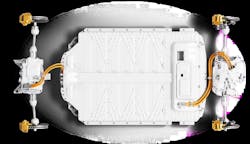Polestar 3 to Adopt 800-V Architecture for Faster Charging and More Power
What you'll learn:
- Polestar 3 is being upgraded with an 800-V electrical architecture and peak DC charging rate of up to 350 kW.
- New in-house developed rear motor and substantial increase in power for all versions, now up to 500 kW.
- Upgraded core computer with more than 8X greater processing power.
- Under ideal conditions, enough power for around 250 km can be obtained in 10 minutes.
With 800-V electric-vehicle (EV) architectures, faster charging times and increased efficiency are possible thanks to lower current requirements. In turn, thinner and lighter cables and smaller electronic components can be used, reducing the vehicle's overall weight.
The latest convert to an 800-V system is the Polestar 3. Built on the same SPA2 platform as the Volvo EX90, the Polestar 3 uses the higher voltage to achieve faster DC charging speeds (charging at a peak rate of up to 350 kW — previously, 250 kW) and improved overall efficiency. In all, this translates to a 10% to 80% battery charge in around 22 minutes, which is approximately 25% faster than before.
The efficiency boost is due to the flow of lower currents when charging with a higher voltage, generating less heat so that the battery can be charged at a higher power level. In particular, battery efficiency is improved by up to 6% based on the WLTP cycle (the Worldwide Harmonized Light Vehicles Test Procedure is an international standard for testing vehicle emissions, fuel consumption, and electric range).
The Polestar 3 will also support the installation of new CATL lithium-ion batteries; a 92-kWh battery pack for the rear motor version and a 106-kWh battery pack for the dual motor and performance variants. The rear-wheel drive setup features passive dampers for sportier handling and control. The all-wheel drive system is said to continuously adapt to road conditions, deactivating the front motor to optimize performance and efficiency.
Range is now up to 635 km (395 miles) in the Dual Motor version. Also, 0- to 100-km/h acceleration takes place in 3.9 seconds in the Performance version, 4.7 seconds in the Dual Motor model, and 6.5 seconds in the Rear Motor model. What’s more, a heat pump warms up the cabin and preserves charge for more time on the road via run-off thermal energy from the electric motors, battery, and ambient air.
Michael Lohscheller, Polestar’s CEO, said, “The upgrades to Polestar 3 are so extensive it’s like an entirely new car. With this upgrade, we continue to deliver on our commitment to add value for our customers through over-the-air software and hardware updates.”
Upgraded Powertrain and Suspension
Polestar 3 benefits from a new in-house-developed permanent-magnet synchronous rear motor that delivers 500 kW of power in combination with the front motor in the Performance version of the EV.
The Front Motor now features automatic disconnect functionality when not needed, improving efficiency and range during every day driving. The new rear motor also means the power balance has shifted to a greater rear bias than before.
The Rear Motor features a 92-kWh battery pack, while the Dual and Performance variants offer a 106-kWh battery pack. As a result, the WLTP range for the 2026 model year will be between 593 and 635km.
An active air suspension employs multiple sensors to detect car, road, and driver input 500 times a second, smoothing out bumpy road surfaces. The active air suspension also adjusts ride height via sensor input.
Greater Computing Power
Arguably the first European software-defined vehicle, Polestar 3 introduces a major upgrade to its core computing system, now based on the NVIDIA DRIVE AGX Orin processor. It replaces the previous Xavier unit, increasing processing power from 30 to 254 trillion operations per second (TOPS). This represents a more than an 8X increase in computing power for faster, more intelligent management of active safety systems, battery performance, and sensor data.
The hardware upgrade will also be offered as a complimentary retrofit to all existing Polestar 3 customers, with upgrades of customer cars planned to start in the beginning of 2026. The complimentary hardware change will be performed at a Polestar authorized service center; customers will be contacted when the NVIDIA DRIVE AGX Orin processor is available to be fitted.
Availability Begins in the UK
The upgraded Polestar 3 will go on sale first in the UK. Other markets will follow at a later date. Future planned models include the Polestar 6 roadster and the Polestar 7 compact SUV.
With its vehicles currently manufactured on two continents, North America and Asia, Polestar plans to diversify its manufacturing footprint further, with production of Polestar 7 planned in Europe.


